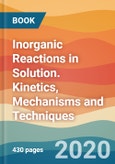The first book on this topic provides an excellent overview and covers all recent developments.
Clearly structured, the first part of the book clarifies the conceptual differences between reaction kinetics and mechanisms, providing an overview of the basics and advanced techniques of reaction kinetics. Relevant experimental and sophisticated computational techniques are shown, along with a detailed discussion of the obvious advantages and potential pitfalls in each case. The second section book focuses on the use of the general principles in selected applications, including ligand exchange, electron transfer, proton coupled electron transfer and atom transfer reactions. As a result of understanding complex mechanisms, the reader learns how to control the corresponding reactions and obtain the desired product.
With its inclusion of current and future applications in such areas as catalysis, biology, environmental chemistry, industrial chemistry and materials science, this is a must–have for inorganic chemists and other researchers either entering or already active in the field.
Clearly structured, the first part of the book clarifies the conceptual differences between reaction kinetics and mechanisms, providing an overview of the basics and advanced techniques of reaction kinetics. Relevant experimental and sophisticated computational techniques are shown, along with a detailed discussion of the obvious advantages and potential pitfalls in each case. The second section book focuses on the use of the general principles in selected applications, including ligand exchange, electron transfer, proton coupled electron transfer and atom transfer reactions. As a result of understanding complex mechanisms, the reader learns how to control the corresponding reactions and obtain the desired product.
With its inclusion of current and future applications in such areas as catalysis, biology, environmental chemistry, industrial chemistry and materials science, this is a must–have for inorganic chemists and other researchers either entering or already active in the field.
Table of Contents
Introduction: kinetics and mechanismPART 1: THE TOOLS OF THE TRADE
Triggering and monitoring chemical reactions: experimental techniques
Simple kinetic schemes: analytical solutions of kinetic equations
Analyzing time dependent kinetic phenomena without a pre–concept
Kinetic models: simple and complex
The stochastic approach
Pitfalls in the evaluation of the experimental data
Parameters of activation: use, misuse and abuse
Corroborating evidence: trends, correlations and chemical structures
PART 2: APPLICATIONS
Ligand exchange and substitution reactions
Electron transfer processes
Proton coupled electron transfer reactions
Atom transfer reactions
Catalytic cycles and chain reactions
Enlightening: the photon as a reactant
A kinetic approach to contrast agents
Reactive oxygen species (ROS)
Enzyme kinetics
Advanced oxidation procedures
Environmental reactions
Kinetics of self–aggregation
Outlook
Index








